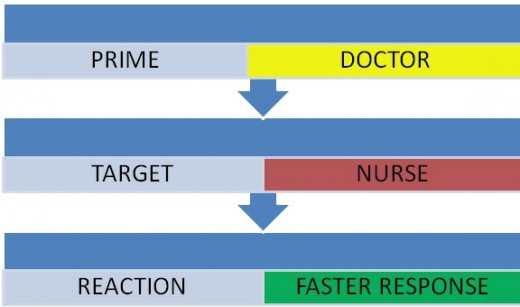Human Cognition: Semantic Priming
Semantic Priming
COGNITION AND HUMAN PERFORMANCE
(name)
(date)
COGNITION AND HUMAN PERFORMANCE
Abstract
Semantic priming has proved to be an important tool when it comes to investigating a variety of cognitive processes that are related to memory, attention and perception. The present report will present several finding, which will help discuss cognition and human performance with regards to response time to words (Bodner and Masson, 2003). This will look at impacts of individual differences on word recognition, extent of conscious and unconscious processing towards stimuli as well as the extent to which words of different emotional valence are processed. The main hypothesis for this paper is that individual differences result in significant differences on word recognition. This it to say that individual differences between people will either increase or reduce word recognition as well as emotionally valence stimuli; negative word valence will in slower processing of the stimuli and that conscious stimulus is processed faster than unconscious stimuli of information (Yap, Balota, Sibley, and Ratcliff, 2012). For this paper, we will present our results and give a brief discussion (Ratcliff, Thapar & McKoon, 2010). Literature review will be used to compare these results and thus determine whether or not they support our argument. From our findings, it can be concluded that all our hypothesis hold true, given that they are supported by a variety of other studies in this field.
Introduction
By saying that a word is recognized, it first has to be identified as having been familiar. For this particular report, it will be the only definition of interest. However, it is important to note that all information, which becomes available when the word has been recognized, may be of significance for researchers in the field. In lexical decision tasks, semantic priming has been shown to increase with increased proportions of related prime trials. Such findings have been taken as the primary evidence for conscious, strategic use of primes. A number of studies have been performed to compare outcomes of semantic priming with and without awareness (Naccache & Dehaene, 2001). According to one of the studies, results of the study suggested that the information perceived without awareness biased the type of stimuli perceived with awareness in addition to influencing how the stimuli was perceived with awareness tend to be consciously experienced. According to popular theory regarding the correlation between spatial and visual word recognition, it is suggested that spatial attention is necessary for word recognition to take place (Besner, Risko & Sklair, 2005). However, a different theory suggests that this is not necessarily the case.
With regards to words with different types of emotional valence, studies have shown that the response time and accuracy data differed significantly between positive and neutral, and positive and negative words respectively. For word pairs with an overall negative valence, the response time was relatively longer as compared to positive. On the other hand, a majority of studies have been able to demonstrate detectable individual differences in response time with regards to word recognition (Bodner and Masson, 2003). However these studies have also concluded that this may vary from word to word. Moreover, the knowledge of higher vocabulary was associated with a much faster and more accurate word recognition performance, attenuated sensitivity to the characteristic of stimuli as well as more coefficient information accumulation.
The overarching aim of this research study is to better understand conscious as opposed to unconscious processing of information. Masked primes have been used to investigate the difference in processing of unconscious and conscious stimuli. Masked primes are words that have been masked so that you are not aware of them.
We used primed words and control (unprimed) words to explore this question (so ‘priming’ is the first independent (within-subjects) variable). To examine the process of masked semantic priming, the following experimental design was run. The primes used were varied, using primes of negative, neutral and positive emotional valence; emotional valence was therefore the second (between-groups) independent variable. The reason different emotional valence primes were used was to examine whether emotional loaded words were processed differently (i.e., unconsciously) as opposed to neutral words.
It is also possible that individual characteristics may influence how a person perceives and responds to emotionally valanced stimuli. To examine this we used two scales, the Spielberger State-Trait Anxiety Index (SSTAI; Spielberger, Gorsuch, Lushene, Vagg, & Jacobs, 1983) and the Oxford Happiness Questionnaire (OHQ; Hills & Argyle, 2002).
The data set
Stimuli Type: The three groups which differ on meaning judgment instruction (negative, neutral or positive valence)
Primed and Control Reaction Time: the time taken to complete the judgment task for either related (primed) or unrelated (control) word pairs
Priming Effect: The difference between reaction times for primed and control word pairs.
SSTAI and OHS: The two different scales have been turned into z-scores. Z-scores are normalized scores that have a mean of zero and a SD of 1. If you have a high z-score with the STAI, you have high anxiety. If you have a high value on the Oxford Happiness index, you have high happiness.
Method
Participants
One hundred and forty-four students from a medium sized university in Melbourne participated in the experiment. All claimed to be native speakers of English.
Materials
Words and Nonwords: Ninety prime-target word triplets were used. The triplets were such that they included two primes and a target word. One of the primes (the control) was semantically unrelated to the target word (e.g., WALL-cat) and the other was semantically related (e.g., DOG-cat). Of the 90 triplets, one-third of the targets had positive emotional valence, one-third had neutral emotional valence, and one-third had negative emotional valence. The word pairs were also balanced on a range of other characteristics like letter length and frequency they appear in the human language. A set of practice words pairs was also used.
In terms of the stimulus presentation, the stimuli always appeared in the center of the screen. The timing was as follows: (a) a forward letter mask appeared for 500ms; (b) the prime was then presented for 48ms; (c) a backward mask appeared for 96 ms; and (e) the mask(s)/target remained on the screen until the participant responded.
Anxiety Scale: The trait items in the Spielberg State-Trait Anxiety Inventory (SSTAI; Spielberger et al., 1983) were used.
Happiness Scale: The Oxford Happiness Questionnaire (OHQ; Hills & Argyle, 2002) was used.
Procedure
Participants were allocated to one of three groups, and sessions were run in groups of approximately 20 people. The task was preceded by 18 practice stimuli. Groups differed only in the instructions given relating to the judgment of meaning about the words: one group judged whether each word presented was negative in valence or not; one group judged whether each word presented was positive in valence or not; while one group judged whether each word presented represented somewhere or a place they could go (neutral emotional valence). Participants were asked to respond as quickly and as accurately as possible. The groups were further counterbalanced such that in one group, half the targets used related pairs and half did not, and the other group used the other half of the stimuli. Following this, they were told that after the main task had finished, that they would be presented with a list of questions, and that they should answer these based on their initial intuition without thinking too hard. The questions were from the two surveys, with the questions from the SSTAI (Spielberger et al., 1983) being presented first and the OHS second (Argyle et al., 1995). The experimental task and the two short surveys took about 15 minutes to complete.
ResultsAll data from the SSTAI and the OHS was initially processed by transforming the raw scores from all of the participants into z-scores. In the main task, all errors were discarded, as were responses in the meaning judgement task that were on stimuli that had a different meaning to the judgment (i.e., positive responses in a negative valence task). Reaction times (RTs) that were 3 or more SDs away from each participant’s mean were removed. The difference in reaction times between primed and control conditions was also calculated. The mean overall RTs appear in Figure 2.
Figure 2. Mean reaction times of judgments for primed and control word pairs a function of word valence. The error bars are 2 SE.
To examine the results, a 2 (Word Type – Positive/Negative/Neutral) × 2 (Prime Relatedness – Related/Different) ANOVA was conducted. The results showed there was a significant main effect of Priming, with related prime-target pairs being faster to process than control (unrelated) pairs, F(1, 117) = 10.23, p < .05. There was also a significant interaction between Prime Type and Stimuli type, with the negative stimuli appearing to show a bigger priming effect, F(2, 117) = 9.98, p < .005. To further examine the interaction, three t-tests were used to examine the size of the priming effect for each of the three stimuli types (negative, control and positive valence). Significant differences were found with the negative, t(39) = 4.73, p < .001, positive, t(29) = 2.65, p < .05, but not neutral words, t(39) = 1.58, p = .12.
To further examine the data, we first calculated the size of the priming effect displayed by each subject (the difference in reaction times between primed and control word pairs). We then correlated the anxiety and happiness scores with these priming effect scores. The results showed that the only correlations that even approached significance were with the anxiety scores and the negative stimuli (r = .31, p = .051) and the happiness scores and the negative stimuli (r = .28, p = .083).
Hypotheses
- Individual differences (including age, knowledge of vocabularies etc.) will affect the response rate of word recognition.
- Negative words valence such as fat that are recognized will result in slower response rates (RT) among participants,
- Positive words such as money will bring about increased response (RT) as compared to negative words,
Discussion
According to the results presented in the Lab report overview, it is clear that high PR have been shown to be proportional to larger priming effects. There are also significant main effects of priming with related prime target pairs being faster to process than control pair. Moreover, a significant interaction was observed between the prime type and stimuli with the negative stimuli appearing to show bigger priming effects. According to these results, the interaction between RP and masked semantic priming present a striking outcome. it can therefore be concluded that null effects could have resulted from the fact that awareness of the prime could be a source of distraction for the participants in the even that SOA is too brief to that extent that it may not have allowed participants to benefit from their awareness. On the other hand, the use of strong RP manipulation could have influenced RP effect that was observed.
The other result of the report also show that individual differences can influence word recognition and that negative word valence also affected response (resulted in slower response), which may be due to the fact that it represents something negative , and thus perceived as a red alert.
Literature review
Semantic priming
This paradigm (semantic priming) has proved significantly essential when it comes to investigating cognitive processes that are related to memory, attention, perception as well as language. in what may be regarded as the typical version of this paradigm, the participants would be required to make a type of response, which may involve lexical decisions, naming or semantic judgment among others to a given stimuli. The stimuli in this case are preceded by a semantically related word or an unrelated word prime. In this case, semantic priming is observed depending on the responses to the target. These may be faster or more accurate for related as compared to unrelated prime- target pairs.
With the manipulation of the relatedness proportion (RP) there are variations to the size of priming effects. larger priming effects in this case may be found when the PR is high and/or when the prime- target stimulus onset asynchrony (SOA) is not less than 300msec. with regards to his paradigm, there are two major processes that have been shown to influence RP. The first account is the expectancy process where the participant or subject tends to generate a likely identity for a given upcoming target while the second one involves the participant noticing and using relationships between given primes and targets to influence the lexical decisions. This study gives more focus to the latter. However both are assumed to be consciously deployed strategies, an assumption that is supported by findings that PR effects tend to be absent when the SOA is lesser than 300msec.
with high RP, a context is created where reliance on priming episodes tends to be to be useful given that these episodes tend to contain information that will be relevant for processing of the target that corresponds. by using masked repetition primes with as low SOAs as 45msec, there are significantly large priming effects when a high proportion of 0.8 instead of low proportion of 0.2 of trials that used repetition primes.
According to a study carried out by Bodner & Masson (2003) participants that were given higher proportions of semantic prime trials demonstrated higher semantic priming in the first experiment. This supported the notion that high RP tends to increase the recruitment of masked prime episodes. with regards to the consistent reports of the effects of RP on the semantic priming at short SOAs, the researchers concluded that this may have resulted from the fact that some of the participants found awareness of briefly presented primes to have been distracting. As a result, this may have obscured a probable influence on priming by RP.
In the second part of the study, researches still found semantic priming to be greater in the high- RP group as compared to the low RP group. However, it was concluded that the high semantic priming was as a result of presenting high percentages of repetition primes instead of high percentages of semantic primes to the high RP group. According to these results, it was suggested that an enhanced reliance in the masked prime resources tends to operate in a general manner.
Conscious and unconscious processing
The unconscious perception largely involves the processing of sensory inputs, which have not yet been selected for the conscious perception. The brain has the capacity to process stimuli that we encounter unconsciously, and not just the ones we consciously attend to. In this case, the brain takes all these signals and goes on to interpret them in ways that tend to influence the manner in which we respond to the environment around us. According to a study carried out by David Meyer and Roger Schvaneveldt (1970) it was shown that people conclude that a string of letters is a word when such letters followed a semantically related word. For instance, the word "Nurse" was recognized quickly when it followed the word "Doctor" instead of the word "Bread" (Merikle & Reingold, 1998). However, other studies have gone a step further to try and determine whether unconscious stimuli are processed to the same extent as the conscious stimuli. Although a majority of studies agree that processing of stimuli occurs unconsciously, they also showed that they are not processed at the same extent as conscious stimuli, which has a higher response time. according to one of the studies (Besner, Risko and Sklair, 2005) it was shown that spatial attention allowed for faster processing as compared to unconscious stimuli processing. However, another published study (Kouider & Dehaene, 2007) showed that the differences in this response time significantly depend on the stimuli.
Emotional valence
According to previous research, studies have shown that cognitive performance tends to be affected negative relative to the positive and neutral stimuli. According to a study conducted by Itkes and Mashal (2015) it was discovered that the response time in the negative condition was slower relative to the positive condition. For this study, the participants had to perform semantic decision tasks on pairs of words that either included a positive or negative target word. Whereas more time was taken in responding to negative a pair of words (positive and negative words) such as fat salary, even more time was taken with words such as fat kid, which were more negative.
A stimulus with a negative valence is assumed to capture more attention automatically. This ensures a fast detection as well as processing of information that is potentially dangerous. The effects of such negative valence have been extensively researched on. In this case, negative valence has been shown to disrupt performance, which may be one of the main reasons as to why the response time tends to be longer as compared to positive valence words or stimuli. In another study carried out by Algom et al (2004) similar results were obtained when participants were asked to name colors that had been imprinted with negative words. In the study, responses were slower regardless of the color. Moreover, it was also noted that participants were slower in performing lexical decision tasks, which included words with the negative valence. In this study, like the former, negative valence resulted in slower performances as compared to the neutral and positive valence stimuli.
Individual differences
Different studies have shown that individual differences result in varying word recognition. According to one of the studies titled "Individual Differences in Visual Word Recognition" researchers also found out that a variety of factors contribute to this outcome. According to the researchers, Yap, Balota, Sibley and Ratcliff (2011) higher vocabulary knowledge is one of such factors. There are limited studies that have considered individual differences. according to this and other studies such as the one carried out by Ashby, Rayner & Clifton (2005) it has been shown that there is a high probability that some inconsistencies in literature may be as a result of individual differences between participants in their respective studies.
For their study, Balota, Sibley and Ratcliff (2011) found out that lexical decision as well as speeded pronunciation latencies are some of the most dependent variables in word recognition. Their analysis was able to establish a clear, substantial between the participant variability on their performance in word recognition across a variety of parameters. According to the results obtained from their study, it was shown that participants tend to carry relatively stable distributional and processing profile, which goes beyond one's average speed of processing. Although the reliability of response time measures may be used here, results would vary significantly given that individual differences would result in significantly varying results depending on various factors such as higher knowledge of vocabularies and the ability to read.
Limitation
For this study, there were a few limitations that should be taken into consideration for future studies. For instance; the measure of vocabulary knowledge in this study is a single measure as a result of the nature of the dataset. Moreover only linear effects of lexical predictors available for most of the words were considered.
Implications
According to the results obtained from these report, it is evident that cognition and processing among individual is affected by a number of factors. For instance, with regards to the recognition of words, and thus a clear response, there are a number of factors that come in to play. These include individual differences and the valence of such words. From these study, it is also clear that semantic priming, or priming in general can be applied in the society; business, society and schools in general to help influence performance. For instance, in business, priming is continually being used to influence consumer behaviors through the use of subliminal messages. This has particularly been used in advertisements to ensure that the central message remains in the mind of the consumer. This proves the value of unconscious processing of information. In conclusion, the significance of priming in the society in general cannot be underestimated. This is due to the fact that it can be used to change behaviors, and thus influence various outcomes.
References
Algom, D., Chajut, E., & Lev, S. (2004). A rational look at the emotional Stroop phenomenon: A
generic slowdown, not a Stroop effect. Journal of Experimental Psychology: General, 133, 323–338. doi:10.1037/0096-3445.133.3.323
Balota, D. A., & Lorch, R. F. Jr., (1986). Depth of automatic spreading activation: Mediated
effects in pronunciation but not in lexical decision. Journal of Experimental Psychology: Learning, Memory and Cognition, 12, 336-345
Besner, D., Risko, E. F., & Sklair, N. (2005). Spatial attention as a necessary preliminary to early processes in reading. Canadian Journal of Experimental Psychology, 59, 99-108. doi:10.1037/h0087465
Bodner, G., & Mason, M. E. J. (2003). Beyond spreading activation: An influence of relatedness
proportion on masked semantic priming. Psychonomic Bulletin & Review, 10(3), 645-652.
Glen E. Bodner and michael E. J. Masson. Beyond spreading activation:
An influence of relatedness proportion on masked semantic priming.Psychonomic Bulletin & Review 2003, 10 (3), 645-652
Hills, P., & Argyle, M. (1998). Positive moods derived from leisure and their relationship to
happiness and personality. Personality and Individual Differences, 25, 523–535.
Melvin J. Yap, David A. Balota, Daragh E. Sibley, and Roger Ratcliff. Individual Differences in
Visual Word Recognition: Insights from the English Lexicon Project. J Exp Psychol Hum Percept Perform. 2012 Feb; 38(1): 53–79. Published online 2011 Jul 4. doi: 10.1037/a0024177
Merikle, P. M., Smilek, D., & Eastwood, J. D. (2001). Perception without awareness:
perspectives from cognitive psychology. Cognition, 79, 115-134.
Meyer, D. E., & Schvaneveldt, R. W. (1976). Meaning, memory structure, and mental processes.
Science,192, 27±33.
Merikle, P. M., & Reingold, E. M. (1998). On demonstrating unconscious perception. Journal of
Experimental Psychology: General, 127, 304±310.
Naccache, L., & Dehaene, S. (2001). Unconscious semantic priming extends to novel unseen
stimuli. Cognition, 80, 215-229
Ratcliff R, Thapar A, McKoon G. Individual differences, aging, and IQ in two-choice tasks.
Cognitive Psychology. 2010;60:127–157. [PMC free article] [PubMed]
Sidis B The psychology of suggestion. In Appleton 1898 New York, NY:Appleton
Spielberger, C. D., Gorsuch, R. L., Lushene, R., Vagg, P. R., & Jacobs, G. A. (1983). Manual for the State-Trait
Anxiety Inventory. Palo Alto, CA: Consulting Psychologists Press.
Priming









